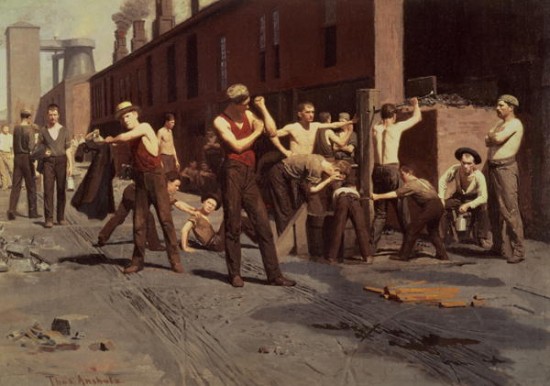The social problem of the future we considered to be, how to unite the greatest individual liberty of action, with a common ownership in the raw material of the globe, and an equal participation of all in the benefits of combined labour.
– J.S. Mill, Autobiography, 1873, speaking of himself and the philosopher Harriet Taylor.
The rich tradition of alternative liberalism has much to offer by way of solutions to inexorably widening inequality—as social movements are beginning to realise.
Thomas Piketty’s Capital in the Twenty First Century argues that, absent corrective action, we can look forward to a rise in capital’s share of national income and a corresponding depression of the share of labour. This might not be so significant were capital evenly distributed so that all could share in its higher returns. But Piketty shows that the distribution of capital is extremely unequal and likely to grow more so. At the same time, he argues, the share of wealth that is inherited looks set to increase. Together these trends threaten to produce a society in which a relatively small section of the population comes to claim a larger share of national income through its (increasingly) concentrated ownership of (increasingly) inherited wealth.
How might we prevent this from happening? In a recent interview with Piketty, Martin O’Neill draws out the connection between Piketty’s concerns and those of the economist James Meade. Writing in the 1960s, Meade envisaged a future in which technological change would reduce the demand for labour and thereby increase the return to capital.[1] Given the highly unequal ownership of wealth, Meade expected this to lead to increased inequality of income. His proposed solution was to explore ways of equalising claims to the return on capital. This could involve measures to widen the private ownership of property (‘property-owning democracy’) and/or to socialise capital and share out the return on this.
Meade’s work fits into a wider tradition of what one might call alternative liberalism. While this tradition endorses both markets and significant private ownership of wealth, its proponents also see a key role for collective action, including action by the state, in determining, for egalitarian purposes, the content of the right to capital and its distribution. I call this tradition liberal because some of its leading theorists, such as J.S. Mill and James Meade, identified as liberals and because the Liberal party in the UK historically drew on and contributed to it.[2] But it is an alternative liberalism to neoliberalism in that it takes a different view of the content of the right to capital and regards rules regulating the distribution of wealth as properly subject to collective determination and an egalitarian conception of the common good.
Without claiming that alternative liberalism offers all the answers to the problems Piketty identifies, I do think it is a useful tradition to engage with. My aim here is to clarify some of its main ideas and discuss its political relevance.
Rights of capital: income and control
Say you have a right to some capital, in particular to some capital invested in a firm. What should the content of this right be? What sort of rights to income from, and control over, the firm should the right entail?
In the historic Liberal party in the UK the answers to these questions centred around notions of profit-sharing and co-determination.
Let’s take profit-sharing first. This term can mean a number of different things, but in the mainstream Liberal party tradition it had a specific meaning. The firm is seen as a partnership of labour and capital. Workers are entitled to a (trade-union negotiated) wage. Capitalists are entitled to a ‘capital wage’, a norm for the rate of return on investment. Any income the firm receives over costs, including the wages of labour and capital, is pure profit. Who has a right to this pure profit? One view, going back to Co-operator Robert Owen, is that labour and capital both have a legitimate claim to a share of this. This is seen as both just in itself and (in some accounts) good for workplace relations and productivity. Some Liberals argued that profit-sharing in this sense should be compulsory (though the details of this were very controversial). Capital should not be allowed, on this Liberal view, to monopolise pure profit to the exclusion of workers. Capital’s right to income does not stretch that far.
At the same time, Liberals argued that capital’s authority in the firm ought to be limited by workers’ rights to consultation and participation in structures of co-determination. The right of capital to control the firm is not absolute. The right to invest in a firm is conditional, on this view, on accepting workers’ rights to share in authority at various levels of decision-making. Participation rights here can include representation on works’ councils and on firms’ governing bodies. The rationale for this was again in part about alleged work relations and productivity, but also about inherent justice. In the words of one Liberal party report from the 1960s:
Just as there is a difference between a citizen and a mere subject, so there is a difference between an employee who is simply hired by his company and one who shares, officially and formally, in the ultimate power to determine the company’s aims and call its directors to account.[3]
Indeed, for some more radical liberals/Liberals the idea of co-determination sometimes gave way to the idea that firms ought to be labour-managed. Firms should be run by their workers. To attract capital, worker-managed firms would of course have to offer a return on investment. But investors would not have a right to directly control the firms themselves. A further step along this road, of course, is to envisage workers owning the firm they manage, either in whole or in part.
We see a vision of this kind in J.S. Mill’s Principles of Political Economy (1848) which argues that ‘the relation of masters and workpeople will be gradually superseded by partnership, in one of two forms:…association of the labourers with the capitalist; in others, and perhaps finally in all, association of labourers among themselves’.[4] And well over a century later, we see Paddy Ashdown, leader of the newly formed Liberal Democrats, returning to the idea of the labour-managed firm: ‘in some cases, the present situation will be reversed…with workers employing capital and even hiring their own management’.[5]
Rights to capital: direct and indirect
Undoubtedly many will find these modifications of the right to capital—the limitation of capital’s income and control rights—too modest. Perhaps in and of themselves they are. But they are just part of the package potentially offered by alternative liberalism. Also important is the way this tradition thinks about the right to capital and the role of collective action in shaping the underlying distribution of wealth.
For much of the twentieth century, the Liberal Party campaigned on the slogan, Ownership for All. The ideal was a society in which all citizens would hold some wealth. In its most radical form, the moral claim is that we have a right to capital as citizens.
At the policy level, Liberals tended for the most part to support rather modest measures to encourage wider ownership, e.g., tax relief for personal saving accounts. Liberals also supported taxation of inherited wealth. Meade considered how one might structure such a tax to motivate a wider dispersion of inheritances. One might think of these policy ideas as instruments that seek to institute a right to capital indirectly, by means of supposedly helpful incentives and/or targeted assistance.
Another possibility is to link profit-sharing (as described above) to the aim of spreading wealth. One idea that played a part in Liberal debates in the 1960s—though it was never formally adopted as party policy—was to use labour’s profit share to invest in firms’ assets so that, over time, workers would build up their own share in firms’ wealth. (This reflected a wider interest in such ideas at the time in Western Europe, an interest which arguably found its most radical expression in the famous ‘Meidner plan’ developed by the economist Rudolf Meidner at the request of the Swedish trade union movement.)
The most direct way to institute a right to capital, however, is simply to make it a basic right of citizenship. In his Agrarian Justice, published in 1797, Tom Paine argued that every citizen reaching adulthood should receive a capital grant from the state, paid for by a tax on inherited wealth.[6] The proposal resurfaced at intervals during the 19th century. Dane Clouston brought it into Liberal party debate in the 1970s (and he continues to advocate it) and it has recently made a comeback not least due to the efforts of Bruce Ackerman and Anne Alstott in their 1999 book, The Stakeholder Society. The idea of a universal capital grant was taken up in the UK in a modest way by the previous Labour government in the form of the Child Trust Fund,[7] one of the first policies to be abolished by the Coalition government.
Another model of a citizens’ right to capital is what we might term the Citizens’ Trust. Meade was somewhat sceptical about the state owning and running particular firms or industries. However, he thought the state should build up its own set of stocks and shares in what Gerald Holtham terms a ‘community fund’ . In Meade’s vision of what he called ‘Agathotopia’ (the good place, though not the perfect place of utopia), he imagines the community owning something like 50% of the nation’s productive assets in this way. The return on this national asset or community fund can then be paid out to the citizenry as a social dividend. A real-world example of what Meade has in mind is the Alaska Permanent Fund. This invests revenue derived from the sale of mineral rights and pays out a modest annual return to every Alaskan citizen.
Extending the Citizens’ Trust idea: basic income
In Meade’s model of the Citizens’ Trust collective asset ownership is seen as a way of securing a basic income: an income paid to every citizen as of right with no means test or work-related condition. However, we don’t necessarily have to think of basic income as something delivered solely through a Citizens’ Trust. Another, complementary, possibility is to consider how the tax-transfer system can be structured to provide a basic income.
There is, again, considerable support for this in the tradition I am calling alternative liberalism. One proposal, currently floated by the Citizens’ Income Trust in the UK, is to fold most existing cash benefits and tax reliefs into a basic income scheme. Another long-standing idea seeks to link specific natural resource taxes to the funding of a basic income. One strand in the liberal philosophical tradition, for example, argues that natural resources such as land are fundamentally the property of all. If individuals wish to use those resources for private purposes, they may do this. But they must pay the community for the privilege. Taxes, e.g., a land value tax, can be used to ‘charge’ natural resource users for their appropriation of part of the commons. The funds can then be recycled to citizens as a basic income, reflecting their right to an equal share of the underlying resources.
Alternative liberalism in practice?
A society designed to satisfy the aspirations of alternative liberalism would look rather different to our own, though familiar in other ways. Some assets would remain privately-owned, though the distribution would perhaps be more equal due to the effects of inheritance tax and basic capital schemes. Many citizens would sell their labour-power to make a living, but the context would be reshaped somewhat by rights of participation in firm decision-making and, not least, by a basic income. Though technological developments might put downward pressure on labour’s share of national income, workers would be compensated for this by their greater access to the return on capital. There is reason to think that such a society would be more distributively and relationally egalitarian than our own. With such measures backed up by strong trade unions, quality public services and other social security payments (such as to cover the additional living costs of disability), a society of this kind would certainly look very different to the scenario otherwise predicted by Piketty.
But can alternative liberalism connect with political practice?
As the discussion above suggests, alternative liberalism did influence thinking in mainstream UK politics in the 20th century. Although the Liberal party was quite marginal for most of the century, the tradition also had some support within the Labour party and, in the 1980s, the Social Democratic Party. However, even then, its impact on actual policy was limited. And, in the last couple of decades, alternative liberalism has struggled to retain a hold within the mainstream ‘centre left’.
Nevertheless, there remain echoes of it in Liberal Democrat and Labour proposals for ‘mansion taxes’. Labour MP David Lammy proposes a shift to taxation of unearned wealth from taxation of income and that we adopt power-sharing and profit-sharing in companies in his 2011 book Out of the Ashes. Researchers at the centre-left think-tank IPPR have also recently explored forms of power-/profit-sharing (Lawton and Lanning 2013, Lawrence and MacNeil 2014), while Martin O’Neill has argued that Labour’s big idea of ‘predistribution’ should be developed in terms of Meade-style notions of ‘property-owning democracy’.
We can also see an interest in some of the ideas associated with this tradition in green and emerging social movement thinking. Amelia Womack, deputy leader of the Green Party of England and Wales, has argued that all workers should have the right to convert their firm into a co-op, a proposal that is now that Party’s policy. The New Economics Foundation’s work on tackling economic inequality has recently included proposals for wider employee share ownership, community share ownership, profit-sharing, and a land value tax linked to a ‘citizen endowment’. Guy Standing’s attempt to imagine a ‘Precariat Charter’ to address inequalities of power and material insecurity in the contemporary labour market includes proposals for basic income and, as also suggested by Angela Cummine, to develop and use Sovereign Wealth Funds in a manner akin to a Citizens’ Trust. Many of these proposals also feature in an attempt to explore a ‘republican’ political economy in an e-book edited by myself and Niki Seth-Smith. There is much common ground, too, with the ideas for ‘community-wealth building’ being developed very concretely by the Democracy Collaborative in the US, though there is a stronger emphasis in their work on the need to root capital in specific places than one usually finds in the alternative liberal tradition. The Little Book of Ideas produced by Occupy London’s Economics Working group has entries on basic income, employee share ownership and land value tax. Basic income in particular seems to be emerging as a core element of a post-Occupy perspective on what a new economy should involve.
At times in the past, alternative liberalism has been an intellectual tradition largely confined to a technocratic elite at some distance from popular movements for social justice. But as new popular movements try to articulate a way forward from neoliberalism, the tradition of alternative liberalism has a lot to offer. Perhaps, as some of its ideas become grounded in such movements, they will find the political traction they lacked for much of the twentieth century.
My thanks to Martin O’Neill for comments on an earlier draft.
This article originally appeared on the website of The New Left Project.









1 Comment
Industrial Relations academic studies should follow up on Piketty & Taleb, as expressed in this cogent review of the field.